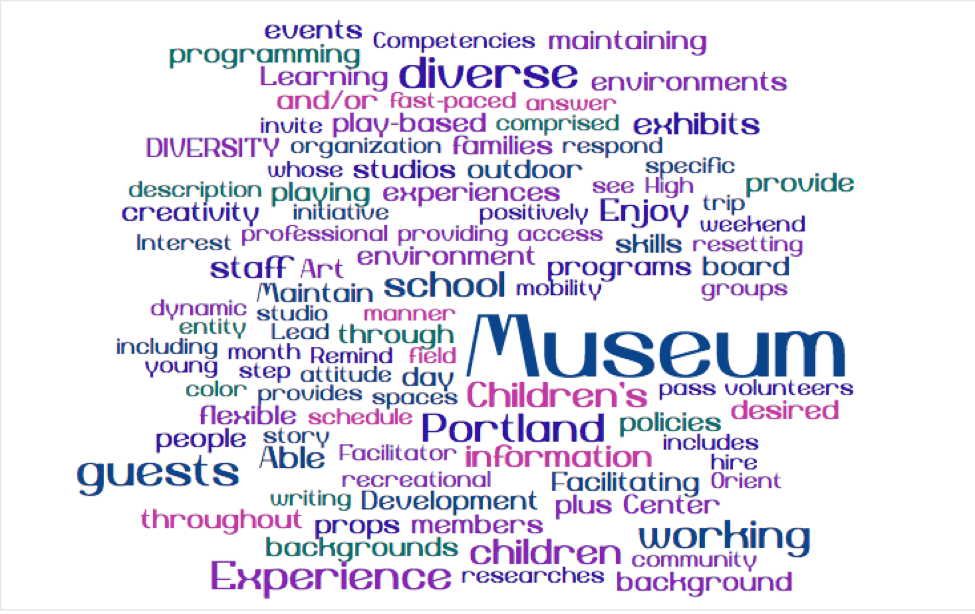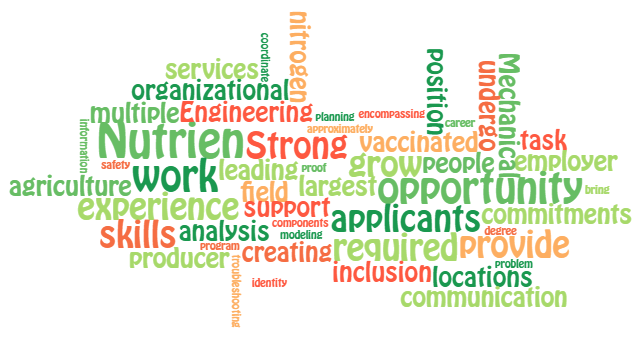5.02: Chapter 18: Application Preparation
- Page ID
- 134485
19
Chapter 18: Application Preparation
Rebekah Bennetch, Corey Owen, and Zachary Keesey
Learning Objectives
By the end of this chapter, you should be able to:
- Use job boards or other means to find a job posting that you can use for your job package assignment
- Conduct a self-inventory to evaluate your skills, achievements, and accomplishments
- Analyze a company’s website or other sources to evaluate its goals and values and establish your connection to the company
- Identify keywords in a job posting that you can highlight in your own application materials to show you “speak their language”
Key Terms and Concepts
- pre-writing
- job package
- self-inventory
- keywords
- action verbs
- rhetorical audience
- rhetorical exigence
Spending adequate time preparing to write your employment materials can save you many headaches in the drafting phase, i.e., the writing phase where you are actually creating your materials. This chapter focuses on the pre-writing phase, which is when you should be gathering information and content to help generate those materials. In this chapter, you will find a potential job that you are eligible to apply for now, conduct a self-inventory of your skills and achievements, research your potential employer, and research the job you have selected. This may seem like a lot of work, but following these steps will make you more likely to stand out from all the other applicants.
Finding a Job

Finding a suitable job opening itself can be a time-consuming process. Here are a few resources to get you started:
- Job boards: browse sites like Indeed, CareerBuilder, Glassdoor and Monster to search for jobs in your field.
- Specialty job lists: look for lists of jobs in specific industries such as agriculture (Western Producer), nonprofits (Idealist), or media (MediaBistro)
- Company, organization and government websites: visit the employment section on websites of companies you admire; search federal, provincial, regional, and city websites for job postings.
- Your own network: talk to classmates, friends, past employers, and professors or visit LinkedIn to search for openings at companies in your network.
- Your college: visit your college or university placement office/career center and attend job fairs hosted at your college. The University of Saskatchewan has specific jobs listed for its students/alumni listed here.
Many job seekers also use Kijiji to look for work; just be aware that Kijiji postings often lack detail and may come from headhunters or placement agencies, rather than from the direct employer.
Once you have found a job, make sure to print and/or save a copy of the job posting or job description. You will use this document to help you tailor your applicationmaterials and prepare for your interview. Because companies often delete the job posting once they have received sufficient applicants, it is important that you save your own copy.
Exercise #1: Finding a Job Posting
One of your assignments for this course is to apply the rhetorical theory you are learning to the job application process.
For this assignment, you will create a job package for a position you are qualified to apply for. The exercises in this chapter will get you started.
Let’s begin by actually finding some potential jobs! Use the options listed above to identify a couple of positions you are qualified for. Looking for internships in your field is a great place to start!
After you have gathered a few job postings, pick one that you are most excited about. This is the one you will use for the job package assignment and for the other exercises in this chapter.
Don’t forget to print or save a copy of the job posting! Once you have the posting ready to go, head on to the next section.
Conducting a Self-Inventory
It’s important to know what you have to offer as a potential employee. As you work on your resume, you may worry that you have nothing valuable to include, or you may worry that you are “bragging.” One way to get over these hurdles is to allocate time to a self-inventory. Brainstorm your skills, accomplishments and knowledge by asking yourself the following questions:
- What did you accomplish at a past of current work, school, or a volunteer position?
- What skills have you learned?
- What would you tell a friend or family member you were proud of having achieved there?
Start writing down skills and action verbs that describe your experiences and accomplishments, and don’t worry about putting them into a résumé format yet.
Exercise #2: Self-Inventory
Let’s take a moment to brainstorm some skills and action verbs that you can use in your job package assignment for this course. The best way to do this is to browse a skill list such as the one below. Do the following steps:
- Scan the groupings of skills (Communication Skills, Creative Skills, Financial Skills etc.) for action verbs related to skills you have or work you have done.
- Write down the categories of skills you have (again, Communication Skills, Creative Skills, Financial Skills etc.) and the action verbs that describe skills you have or work you have done (e.g. analyzed, performed, calculated, advocated, etc.).
For example, you probably have done quite a few team projects in school already. You could probably pick “Communication Skills” and “Collaborated.”
| Communication/ People Skills | Creative Skills | Management/ Leadership Skills | Helping Skills | Organizational Skills |
| Collaborated | Combined | Assigned | Aided | Arranged |
| Communicated | Created | Coordinated | Arranged | Categorized |
| Developed | Developed | Decided | Assisted | Distributed |
| Edited | Drew | Improved | Contributed | Organized |
| Incorporated | Illustrated | Led | Cooperated | Recorded |
| Proposed | Planned | Managed | Encouraged | Responded |
| Suggested | Revised | Oversaw | Helped | Updated |
| Synthesized | Shaped | Recommended | Motivated | Tracked |
| Translated | Crafted | Reviewed | Supported | Monitored |
| Facilitated | Conceived | Supervised | Prepared | Synthesized |
| Mediated | Established | Delegated | Bolstered | Adapted |
Table adapted from Creating Resumes I by Roads to Success, licensed under CC BY-SA 4.0.
For an additional list of action words for your job package, check out the Usask’s Career Centre’s materials on résumés and cover letters.
As you gather information about your work history and skills, double check that your information is accurate and current. Gather dates of employment, dates of trainings, lists of activities you have been involved in, academic awards, achievements and special projects. If you’re having trouble remembering the information, ask former coworkers or managers about your significant workplace contributions.
Researching Your Potential Employer

As we’ve already discussed, you must adapt your job package materials to your potential employer because they are your rhetorical audience. Of course, to know your audience means you will need to first take the time to do a little research. It is important that you research your potential employer as well as the job for which you’re applying. The easiest way to research a potential employer is to visit the company’s website.
Look for an “About Us” page or a “Mission Statement,” and observe how the company describes its goals and values.
Try to answer the following questions about the company or organization:
- Whom does this company serve?
- Who are this company’s partners or competitors?
- What technologies would I use at this company?
- What is the tone of this company’s materials (formal, conservative, humorous, “cutting edge,” etc.)?
- How would you describe this company’s brand?
Here are a few more ways to research a company: search for its name on LinkedIn and other social media sites, browse for news articles about the company or press releases written by the company, speak with friends or colleagues who work for the company, or call the company to request an informational interview. This may seem like extra work, but this research can help you analyze the needs of your rhetorical audience and, as a result, better market yourself as a solution to those needs.
As you research, look for ways to connect with the company:
- What do you admire about the company?
- Where do your values and interests overlap with those of the company?
- What makes this company a good fit for you?
Try to summarize your connection to the company in one sentence. Remember that your potential employer is also your rhetorical audience, and adapt your tone, examples, and level of technicality accordingly.
Exercise #3: Research the Employer
It’s time to research the company where you are applying!
Using the company from your job posting, find the company’s “About Us” and/or “Mission Statement” page and try to answer the questions listed above. You may need to look at other parts of the website or online to find some of the answers. The job posting is also a great place to find this info.
Once you have your answers, try to summarize your connection to the company in one sentence. What is it about this company that makes you want to work for them? What part of their goals and/or values do you most respond to? A sentence that explains this information would be great for the first paragraph of your cover letter!
Researching the Potential Job
To research the job itself, take advantage of the job posting you found. The job posting is your secret weapon; in this document, you are told what the employer is looking for in a candidate.
Exercise #4: Researching the Job
The job posting will give you insight into the rhetorical exigence that a company needs solved. Obviously, the solution is you! The best way to figure out how you can solve that problem is by scouring the job posting and making connections to the words in it.
You want to get into a conversation with the document as you go over it, so you will need a way to annotate the posting. Either print it out or copy and paste it in a document editor like Microsoft Word. Once you have the document ready, take the following steps:
- Highlight or underline any qualifications that you hold—any skills you have, technologies you’ve used, etc.
- Make note of any past achievements that relate to any of the preferred qualifications. Ideally, try to use the achievements and experiences you generated from Exercise #2. For example, if the job description seeks a candidate who can diagnose and solve technical problems, write down an example of a specific time in which you did so in a professional or academic setting.
- Circle any keywords you might use in your own materials. Using the same terms as a potential employer demonstrates to that employer that you are able to “speak their language.”
- Note any questions/uncertainties and any qualifications you do not have in order to decide what to highlight and what to downplay in your materials (as well as what you need to learn more about).
Any content you find through this process can be discussed in your application materials. You may not end up using all of the content you generate, but its important to have options when trying to appeal to your rhetorical audience—the company.
If you’re having trouble identifying keywords, creating a word cloud from the job description might help. This can be accomplished by using a website like EdWordle. Word clouds present text as a visual display, reorganizing content so that the largest words are those that appear most frequently in the analyzed text(see Figures 1 and 2 below). A word cloud can be a helpful visual tool to identify keywords to use in your résumé and cover letter. You might also be surprised to find that a “big word” (a commonly repeated keyword) is one that you would not automatically associate with the job.
For example, Figure 1, below, is generated from a job posting for a Children’s Museum Experience Facilitator position. What words stand out to you?

We can see in Figure 1 that some of the words are obvious terms we would expect to find in a children’s museum job description—museum, children, exhibits, playing, etc. However, “diversity” and “diverse” are both large terms, too. If you were applying for this job, you would now know to talk about your commitment to diversity/experience working with people from diverse backgrounds.
Now you try. Figure 2, below, is a word cloud generated from a job posting from Nutrien for a summer student position targeted towards Mechanical Engineers. What words stand out to you?

Obviously , certain words like “Nutrien” and “Engineering” are no surprise. However, there are a few keywords we can pull out of this—communication, inclusion, analysis, organizational. Now you know a few areas and skills that you should speak to if you are applying for this position.
Exercise #5: Keyword Analysis
Generate a word cloud using your job posting. You can do this by using a website like EdWordle.
What words stand out to you? Are there any words that you didn’t notice back in Exercise #3? Try to identify at least 3-4 keywords that you will be able to speak to in your job application materials.
Key Takeaways
- Creating a job package can be a time-consuming process. However, you can make the process easier by engaging in some pre-writing activities.
- To find a job posting, you are not limited to using all-purpose job boards like Indeed. There are specialty job boards like Idealist that target specific job interests and some companies only post jobs on their websites. Also, you can tap into your existing networks that you already have access to such as friends, family, and University of Saskatchewan Career Services.
- Companies are your rhetorical audience. They want to know that you will align with their goals and values. You can learn what those are by using the “Mission Statement” and/or “About Us” page on the company’s website or by searching the internet. Once you know this information, you should be able to summarize your connection to the company in a single sentence.
- You are the solution to a company’s rhetorical exigence. The best way to show this is by identifying keywords in the job posting and connecting those keywords to your skills, accomplishments, and achievements in your application materials.
Attributions
This chapter is adapted from “Technical Writing” by Allison Gross, Annemarie Hamlin, Billy Merck, Chris Rubio, Jodi Naas, Megan Savage, and Michele DeSilva (on Open Oregon). It is licensed under Creative Commons Attribution-NonCommercial-ShareAlike 4.0 International License
Photo #1 by Firmbee on Unsplash
Photo #2 by Clem Onojeghuo on Unsplash

